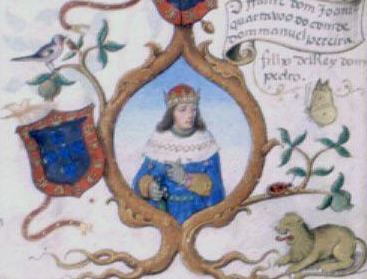Religion Roman Catholicism House House of Burgundy Name John, of | Died 1397, Salamanca, Spain Mother Ines de Castro Siblings Ferdinand I of Portugal | |
 | ||
Issueamong others... Infante Fernando, Lord of Eca Spouse Constance of Castile, first Lady of Alba de Tormes (m. 1378), Maria Teles de Meneses (m. 1376–1378) Children Ferdinand of Portugal, Lord of Eca Parents Peter I of Portugal, Ines de Castro Similar People | ||
John of Portugal ([ʒuˈɐ̃w̃]; Portuguese: João) (1349–1397) was the son of the Portuguese King Peter I and a Galician noblewoman named Inês de Castro who had arrived in Portugal as a lady-in-waiting to Infanta Constance of Castile, recently married to Pedro I (royal heir at the time).
Contents
Background
The status of John I as Infante of Portugal is a debatable subject. Some historians consider him a natural son of Peter I, and so assert that the title 'Infante of Portugal' could not be attributed to him. Others refer to the circumstances of the death of Inês de Castro, ordered by Peter's father, King Afonso IV of Portugal: after inheriting the throne, the Prince admitted he had married Inês secretly, therefore she was a lawful Queen of Portugal and he was legitimized as Infante of Portugal.
Life
The Duke Infante lived at the Court of Ferdinand I, and was esteemed as a good knight, a dexterous rider and able hunter, valiant in shooting. He had a steady friendship with the Master of Avis, his half-brother, who was valiant and daring as he, but very different in character. Infante John was a dissembler, ambitious and bold, and would not hesitate to act or speak in pursuit of his ambition.
He fell in love with María Teles de Meneses (born circa 1338 in Coimbra, died 1378 or 1379), a redheaded beauty about eleven years older than he, who was lady-in-waiting to the Infanta Beatrice and sister of Queen Dona Leonor Teles. María was the widow (circa 1360) of Álvaro Dias de Sousa (circa 1330–1365), 2nd Lord of Mafra and Ericeira, by whom she had conceived Lopo Dias de Sousa (1350–1435 Pombal), who inherited his father's titles and later became Master of the Order of Christ. Infante John, having gone to her house to fetch her, found an altar and a priest waiting; María had made the preparations for their wedding. Thus the marriage was performed secretly in 1376, and when it became public knowledge, it provoked the wrath of Leonor Teles. Upon the death of Ferdinand I with no male heir, the people might demand the crowning of the beloved Infante John as king, which would raise his wife to the throne, with grave consequences to herself (Leonora), hated as she was by the Portuguese people.
Leonor persuaded her brother João Afonso Telo 6th Count of Barcelos and Alcaide-Mór (noble magistrate) of Lisbon, to insinuate the idea in the mind of the Infante that his marriage to her daughter, the heiress presumptive Beatrice (who was promised to John I of Castile), would find favour with the people and clear his way to the throne. With the false imputation that his present wife María had been unfaithful to him, transmitted by Leonora through John Alfonso, Infante John became so enraged that he stabbed María in Coimbra. In one single coup, Leonor Teles got disentangled of her sister and brought such opprobrium upon the name of her brother-in-law, that his hopes of succeeding to the throne were much diminished.
Having committed this crime of passion, John fled to Beira. Ferdinand I intended, or pretended he would, to punish the culprit, but he was soon forgiven and returned to his place in the royal court. When he spoke, however, of marrying his half-niece, the Infanta Beatrice, the Queen herself disillusioned him. Infante John, realizing he had been ensnared by the machinations of Leonora, retired to the Douro and then to Castile, avoiding the persecution that was encouraged by the cunning Leonor.
Henry II called Infante John to his court and gave him in marriage his illegitimate daughter Constance of Castile, first Lady of Alba de Tormes, in Valencia de Campos in about 1378. There he became the first Lord Duke of Valencia de Campos, consequently renamed Valencia de Don Juan. When the Castilian army invaded Portugal, John joined its ranks and laid siege to Elvas, which held firm. Upon the death of Ferdinand I, John I of Castile had him arrested, considering him a threat as the most direct successor to the Portuguese throne. Meanwhile, his connections with Castile eventually cost him the throne, thanks to the argumentation of Master João das Regras at the Cortes of Coimbra in 1385. During the Battle of Aljubarrota he was already out of the country like his brother Denis, both of them having left Portugal for Castile, although during the 1383-1385 Crisis he was one of the claimants to the throne, along with Beatrice of Portugal (his half-niece), John, Master of Aviz (his half-brother) and Denís (his brother). He eventually died in prison (1397) at Salamanca, and was buried there.
Issue
His first marriage, in 1376, was to Maria Teles de Meneses, the widow of Alvaro Dias de Sousa. She was the daughter of Martim Afonso Telo de Meneses and his wife Aldonça Anes de Vasconcelos. From this marriage he had one son:
His second marriage, in about 1378, was to Constanza Enríquez de Castilla, illegitimate daughter of Henry II of Castile. From this marriage he had three daughters:
Out of wedlock he had:
